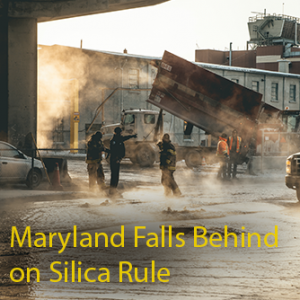Maryland Remains Behind on Silica Standard
It has been more than two years since OSHA released its final rule on Silica Dust in March 2016 — yet, Maryland’s state-run OSHA continues to delay change. Administration officials have stated that they are waiting to enforce new standards until all legal revisions of the rule have been finalized. The main case against the rule was dismissed last December, leaving Maryland struggling to rationalize its failure to protect workers.
Crystalline Silica is a hazardous substance that can enter the lungs as a dust in industries such as construction, maritime, and shipyard. This dust can wreak havoc on the lungs and lead to severe health complications including silicosis, lung cancer, chronic obstructive pulmonary disease (COPD), and kidney disease.
OSHA’s new rule updated 45-year-old standards that failed to recognize reasonable exposure limits to the hazardous substance. The agency estimates that about 2.3 million workers are exposed to silica in their workplace. OSHA estimates that these new standards will prevent more than 900 cases of silicosis and 600 deaths each year.
(Related Article: Silica Rule Remains Unchanged in Court of Appeals)
Federal v. State OSHA
Maryland is one of the 21 states that enforces OSHA programs for their private and public sector workers. States are allowed to run their own programs in hopes that it will lead to innovation, and expansion in areas where federal-run agencies are limited.
These state-run agencies are required to have programs that are “at least as effective as” the federal program. In Maryland, this is not the case for the silica standard.
After a new rule is issued, states have a six-month period to implement their standards. States can extend this deadline as long as they make “a timely demonstration that good cause exists for extending the time limitation.”
Last September, Scott Schneider, the former director of occupational safety and health for the Laborers’ Health and Safety, questioned the state’s progress in adopting the standard. Commissioner of Labor and Industry Matthew Helminak responded that Maryland OSHA was going to wait out the legal challenges that had been brought against the standard by the construction industry.
Since the industry’s legal challenges were dismissed last December, Maryland was questioned again on their progress. Maryland Secretary of Labor Kelly M. Schulz stated that Maryland was still awaiting a better explanation of medical removal protection (MRP) under the new standard.
The full statement read:
“Maryland Occupational Safety and Health (MOSH) is still awaiting a final rule from OSHA before adopting a new rule. Once approved, MOSH will begin the process of adopting the new OSHA standard. Final regulations are expected to be published in the Maryland Register within six months of federal enforcement, which is the normal timeline for revising federal standards. Until new regulations are issued, the existing silica standard is still in effect across Maryland and MOSH stands ready to assist contractors to remain in compliance and enforce any violations.”
While they Wait, Workers are Exposed
Waiting for legislation around a rule to resolve before implementing any new standards is unprecedented. Especially since modification can take months, if not years to put into effect. It could be several months before OSHA issues their justification for not including MRP. Then, if the agency decides to propose inclusion of MRP, it could be years before the standard is actually modified.
In that amount of time, thousands of workers in Maryland would continue to be exposed to the dangers of crystalline silica. Federal OSHA may end up having to take action against the state for delaying its program, which would not be the first time that has happened. OSHA has several options for enforcement, such as the “Death Penalty.” In that case, federal OSHA would rescind the state’s authority to operate a state program. Unfortunately, that is a long and costly process.
Another option that has been used effectively is the “bully pulpit,” or making media and politicians aware that the state’s actions are endangering workers.
What to Do in the Meantime
If you are an employer in Maryland, ultimately, the onus is on you to protect your workers. Exposing them to dangerously high levels of crystalline silica could mean serious consequences for them and you down the road.
At Worksite Medical, we can help you institute a medical surveillance program. Our mobile medical units can come directly to your worksite and test workers to make sure they are safe and healthy. We also have a standalone clinic in Belcamp, MD that offers silica testing and workplace injury care. It’s never been easier to stay in compliance. We make sure that your workers won’t have to miss work. Give us a call today at 1-844-OCCUMED.




